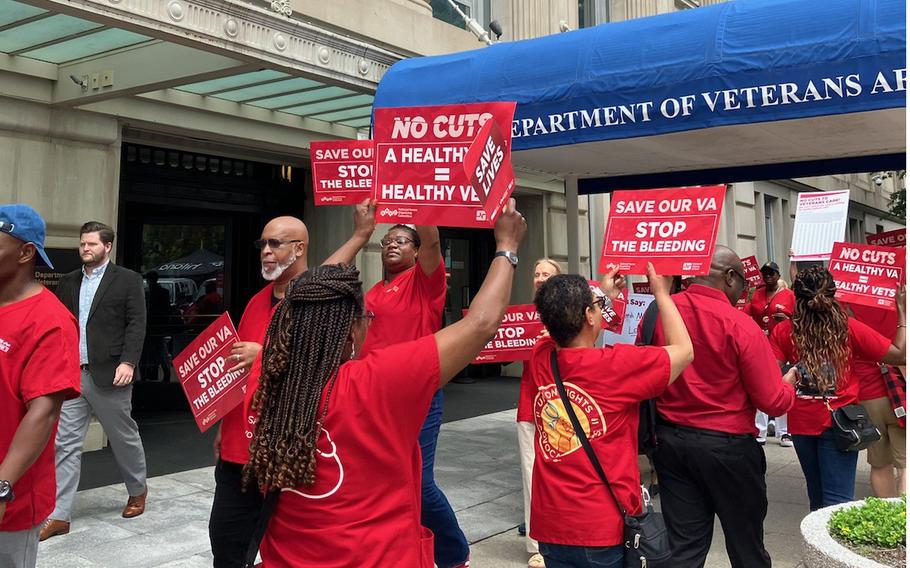
VA nurses rally outside the administration’s headquarters in Washington over staffing shortages in June 2024. (Linda F. Hersey/Stars and Stripes)
WASHINGTON — A severe shortage of doctors and nurses have persisted for a decade at Department of Veterans Affairs health facilities, according to a new report by the VA Office of Inspector General that found chronic vacancies and recruitment challenges continued in 2024.
“Every year since 2014, the medical officer and nurse occupations were identified as severe shortages in [the inspector general’s] annual determination of occupational staffing shortages reports,” according to the IG report released Wednesday.
In fiscal 2024, most VA hospitals and clinics reported critical shortages of nurses and medical officers, which are physician positions.
The report — based on an annual survey of VA health facilities — also shows signs of improvement since 2023, with staffing shortages easing up slightly in some areas.
Severe shortages in nursing jobs were reported by 82% of health facilities in 2024, which was a 10% decrease from 2023.
In June, the VA reported efforts to address the nursing shortage, including aggressive recruitment that had increased the nursing workforce by 14,000 nurses, according to the agency.
A severe shortage of doctors was reported by 86% of VA hospitals and clinics in 2024. The figure was down 2% from 2023 and 5% since 2018, according to the report.
Shortages of doctors spanned a range of specialties, including anesthesiology, gynecology, pain management, oncology and ophthalmology.
The physician shortage follows a national trend, with the Association of American Medical Colleges projecting a shortage of 86,000 medical doctors by 2036.
Other health care occupations in 2024 with severe vacancies included psychology, with 61% of health facilities reporting a shortage, down from 65% in fiscal 2023.
Psychology has been among the top clinical occupations with severe staffing shortages since 2019, according to the report.
Practical nursing followed at 60%, psychiatry at 47%, nursing assistants at 46% and medical technologists at 45%.
But the audit also found hiring improved slightly among most of those occupations. Fewer VA health facilities reported severe shortages for those occupations compared to last year. Shortages eased by 2% to 5% from 2023.
A total of 28 occupations were identified with severe staffing shortages by at least 20% of VA hospitals and clinics, according to the audit. Of that total, eight were nonclinical jobs.
Among nonclinical occupations, the audit found 59% of VA health facilities reported a severe shortage of custodial workers, followed by medical support assistance at 50%.
Medical support assistance includes workers who handle appointment scheduling, records management and customer service.
Other nonclinical positions with severe worker shortages included police officers with 43% of VA facilities reporting critical problems, followed by food service workers at 37%, and biomedical engineering at 26%.
Overall, the audit found in 2024 that VA health facilities reported a total of 2,959 severe occupational staffing shortages, a 5% decline from 2023.
One facility reported shortages in 97 different occupations while two facilities reported having no severe occupational staffing shortages, according to the audit.